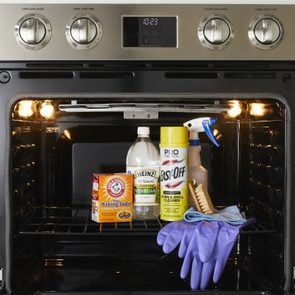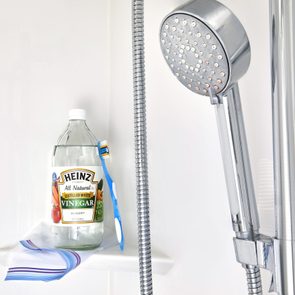How to Clear a Clogged Sink Drain—Without Needing to Call a Plumber
Updated: Jun. 02, 2024

With these simple steps, you can learn how to unclog a sink and save yourself a call to the plumber
You use your sink on a daily basis to rinse everything from your hands, body and hair to dishes and veggies. So when water starts draining a little more slowly than usual, it might signal a clogged sink. It happens to the best of us, which is why it pays to know how to unclog a sink. Reader’s Digest consulted plumber Alan Soukup, owner of Bluefrog Plumbing and Drain of North Dallas, Texas, and cleaning expert Alicia Sokolowski, president and co-CEO of AspenClean, to explain how to clear a clogged drain yourself to get your life back to normal sooner.
“Sinks and drains get clogged when hair, grease, soap scum, food pieces and other debris go down the drain,” Sokolowski says. You know how to clean these gross things in your sink, but a clog? Your first instinct might be to call a plumber, but learning how to unclog a sink yourself is much easier than you would imagine. Plus, it can save you a lot of money.
Surprisingly, kitchen and bathroom clogs have multiple similar solutions. Your garbage disposal adds a step to unclogging a kitchen sink, but Soukup walks us through everything you need to know. (It’s also a smart idea to learn how to clean a garbage disposal to keep it running smoothly.) One word of caution: Though do-it-yourselfers sometimes recommend using boiling water to clear a clogged sink drain, you’ll want to steer clear. “Never do this,” Soukup says. “If the blockage is from grease or other soft solids, it will melt it temporarily but reform further down the line, possibly out of reach of a normal sewer auger.”
Ready to get your sink in working order? The experts’ simple step-by-step guide will have you clog-free in no time.
Get Reader’s Digest’s Read Up newsletter for more cleaning, humor, travel, tech and fun facts all week long.
About the experts
|
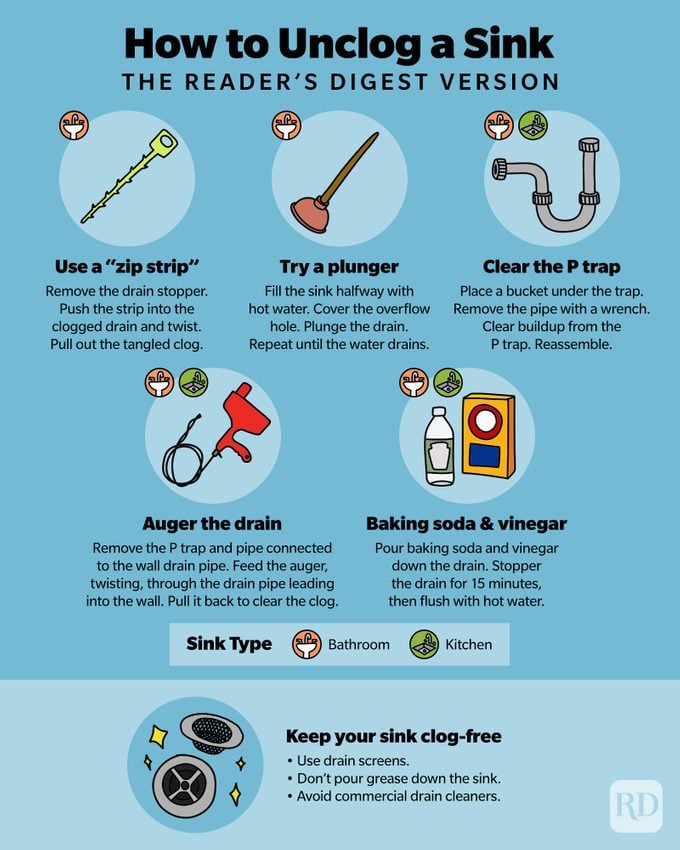
How to unclog a bathroom sink
Bathroom clogs are likely to be a grimy combo of hair, soap and hard water residue, according to Soukup, and the first thing to try is a handy little tool that tackles all three: a zip strip. Of course, there’s always the chance an earring or Lego dropped down the drain, but the initial remedy is the same. Start with the easy option, then break out the more complex tools if your clog persists. Here’s what to do:
Use a “zip strip”
Bathroom sink clogs are largely composed of hair, Soukup says, so start with this innovative plastic device that has barbs along its length to grab and remove hairy clogs. This genius product is available at hardware stores, home centers and online retailers, and it’s an inexpensive first step when trying to unclog a bathroom sink.
- Remove the drain stopper.
- Push the barbed strip into the clogged drain.
- Turn the strip, or follow the directions for your specific tool.
- Pull out the tangled clog.
Try a plunger
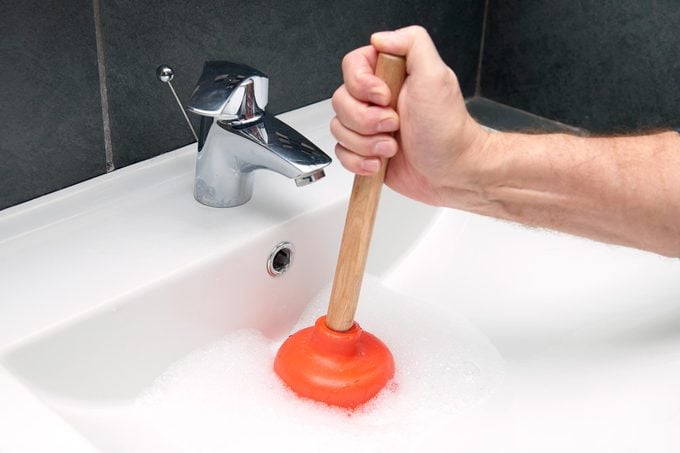
If the drain’s still backed up and the zip strip didn’t grab the clog, Sokolowski suggests trying a plunger. No, not that one. Get a sink-only plunger for this job and leave the toilet plunger behind your toilet. Be aware that this method will be most effective if you can remove the stopper completely and have a clear path into the drain.
- Fill the sink about halfway with hot tap water.
- Position the plunger over the submerged drain.
- Cover the sink overflow (the small drain hole in the basin) firmly with a folded cloth. If you skip this step, plunging the sink will send a stream of water up and out the overflow hole and onto your stomach.
- Pump the plunger multiple times to force water into the clogged drain.
- Remove the plunger and check to see if the drain is clear.
- Repeat if necessary.
Try vinegar and baking soda
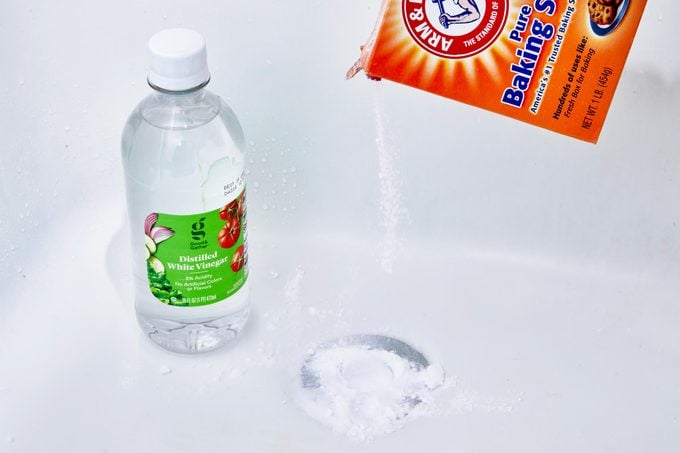
Want to know how to unclog a sink with a homemade drain cleaner? This popular method may be worth trying, but be aware it’s not the plumbing expert’s go-to. “For very light clogs, this may be a solution but can make a bigger mess if it needs to be cleared in a conventional way,” Soukup says. And don’t expect this DIY combo to get rid of hair clogs.
We asked the plumber if vinegar and baking soda are bad for your drain pipes, and he said they’re fine, if questionably effective: “They are not bad for pipes,” Soukup says, noting that they often don’t work. “But it’s worth a try!” Use this method if your drain is merely slow, not blocked, and be prepared to move on to the next method.
- Remove any standing water in the sink and allow slowly draining water to clear the drain.
- Pour a cup of baking soda into the drain.
- Add a cup of plain white vinegar.
- Stopper the drain for 15 minutes, allowing the bubbling to agitate the material in the pipe.
- Flush with hot tap water and repeat if it seems to be working.
Clear the P trap
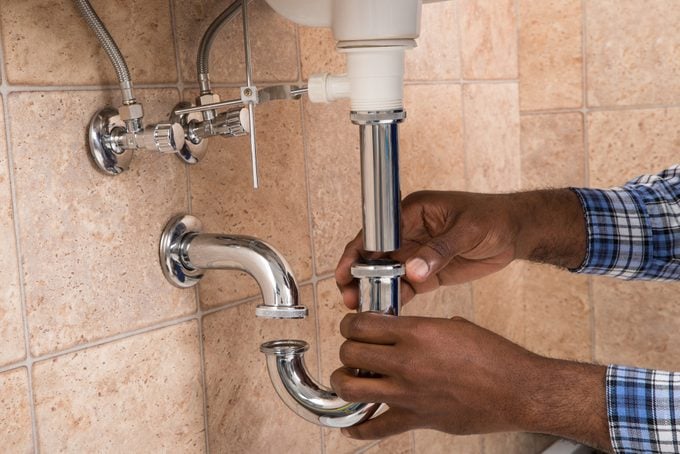
Still stuck? It’s time to remove the P trap, which is the bent pipe under the sink. If something falls down the sink, or if a clog develops from hair or everyday buildup, the P trap is where it’s likely to land. Soukup says removing the trap also gives you access to clear the drain pipe if the clog is farther down.
Just don’t forget to put a bucket below the pipe! Things can get messy, and if you don’t have a bucket to collect material, you may end up having to clean your entire bathroom.
- Place a bucket under the trap.
- Remove the pipe with a wrench.
- Clear debris from the P trap by pushing out the clog, if found.
- Reassemble the piping and test the drainage.
Auger the drain
If you’ve checked the P trap and there’s nothing clogging the works, the clog is in the drain pipe. Your next step is to use an auger, or drain snake. You’ll find the device at hardware stores and can choose from manual or hand-crank, battery-powered and electric augers.
Soukup says you should do it with the P trap removed—never through the sink drain—because you can damage the porcelain or even break your sink. Going through the sink is also likely a waste of time; the extra auger turns needed to get down the sink drain will make it difficult to reach the clog, he says.
- Remove the P trap to gain access to the drain.
- Take off the section of pipe that goes from the P trap to the wall.
- Feed the auger through the drain pipe leading into the wall, twisting the auger as you advance.
- If you feel the auger reach the obstruction, give it another couple of turns to grab it.
- Pull the auger back to remove or clear the clog.
- Repeat as necessary.
How to unclog a kitchen sink
Clogged kitchen sinks aren’t likely to be caused by hair, so you can skip the zip strip and go straight to other methods. Another important difference between the kitchen and bath? The garbage disposal.
“Do not attempt to clear a clog through the garbage disposal,” Soukup says. You’ll want to start there, though, to make sure everything is working like it should be.
Check the disposal
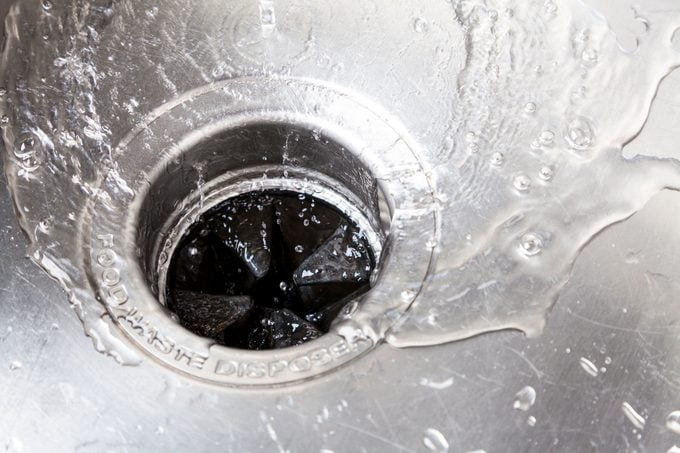
If your kitchen sink is clogged, first run the disposal. If it is spinning freely but nothing is draining, the clog is past the disposal. Unplug the disposal and skip to the next method. “If the disposal is not spinning but humming, the blockage is likely in the disposal,” Soukup says.
Here’s how to clean your kitchen‘s garbage disposal of the gunk clogging it:
- Unplug the disposal.
- Look for the Allen wrench that came with your disposal (often it is taped right to the side or stored under the sink).
- Insert the Allen wrench into the slot on the bottom.
- Crank the wrench a few times to dislodge what’s stuck.
- Plug in the disposal and verify that it’s grinding and draining. You may need to press the reset button on the bottom.
Try vinegar and baking soda
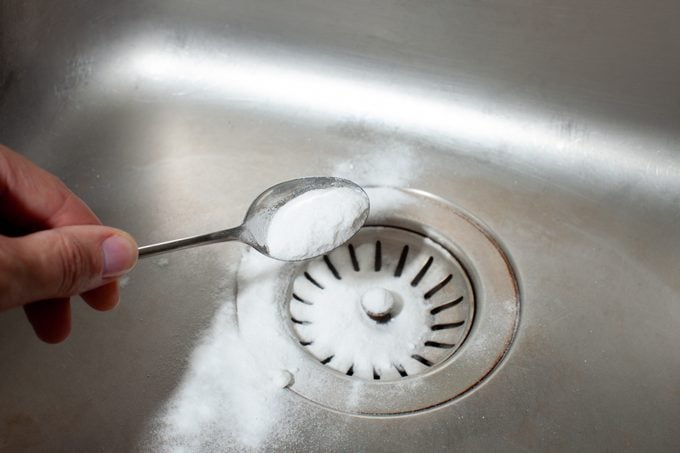
This may be one of the easier methods—and there’s no harm in giving it a go before you move on to the P trap and drain—but don’t expect great results. The bubbling action that results when vinegar (a weak acid) and baking soda (a weak base) combine can dislodge a light coating of grease and food particles, but Soukup says it isn’t going to eat through major blockages.
- Remove any standing water in the sink and allow the drain to clear.
- Pour a cup of baking soda into the drain.
- Add a cup of plain white vinegar.
- Stopper the drain for 15 minutes, allowing the bubbling to disturb the material in the pipe.
- Flush with hot tap water and repeat if it seems to be working.
Clear the P trap
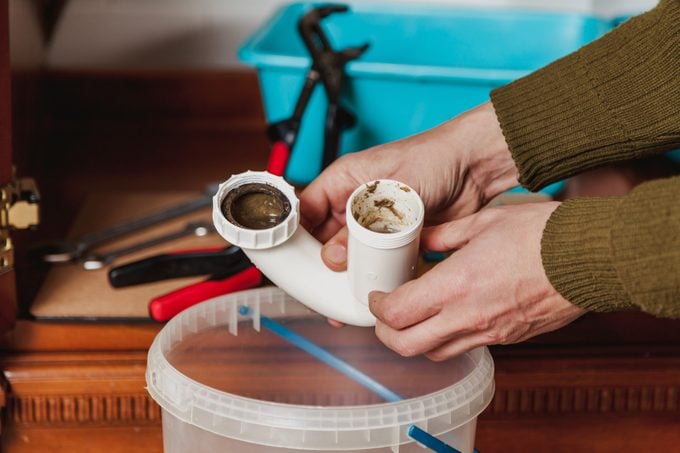
If the problem isn’t in the garbage disposal and the baking-soda-and-vinegar method was a bust, it’s time to take off the P trap and potentially auger the drain pipe, just like you would in the bathroom. In fact, if the disposal itself isn’t clogged with food, you’d be smart to focus your attention on the P trap and drain pipe instead of bothering with baking soda and vinegar.
- Unplug the garbage disposal.
- Place a bucket under the trap.
- Remove the P trap with a wrench.
- Clean out the trap to clear clogged or greasy kitchen buildup.
- Reassemble the piping and check the drain and disposal.
Auger the drain
If the P trap is clear but you’re still facing a clog, you’ll need to auger the drain pipe going into the wall. Remember, when augering the drain, you always want to remove the P trap first!
- Remove the P trap to gain access to the drain.
- Take off the section of pipe that goes from the P trap to the wall.
- Feed the auger through the drain pipe leading into the wall, twisting the auger as you advance.
- If you feel the auger reach the obstruction, give it another couple of turns to grab it.
- Pull the auger back to remove or clear the clog.
- Repeat as necessary.
- Reassemble the pipes and check the drain and disposal.
How to prevent your sinks from clogging
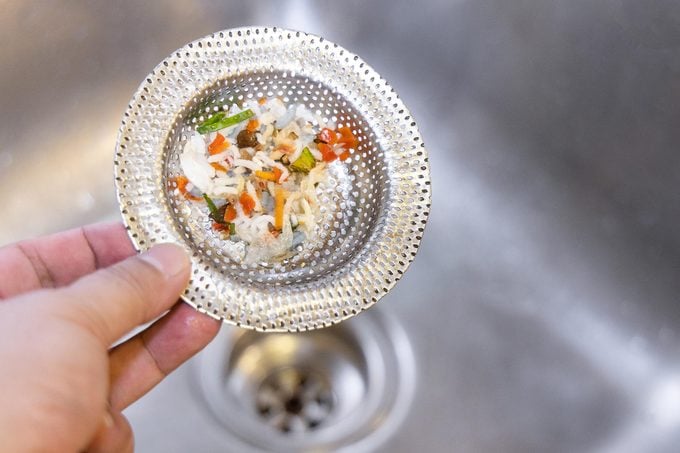
Just as important as learning how to unclog a sink is preventing it from happening in the first place. Follow these expert tips to prevent buildup in your drains and keep your pipes in good shape.
- Use drain screens on your kitchen and bathroom sink drains. These clever little catchers prevent hair, food, contact lenses, earrings and who-knows-what-else from finding their way down your drain.
- Never pour grease or oils into your drains, and always run cold water when using your garbage disposal. Hot water softens fats, which can resolidify in your pipes and cause a clog.
- Avoid commercial drain cleaners, which rarely work, are bad for your pipes and create a dangerous situation for plumbers (or you!) when you have to unclog the pipe manually.
Why trust us
At Reader’s Digest, we’re committed to producing high-quality content by writers with expertise and experience in their field in consultation with relevant, qualified experts. For this piece on how to unclog a drain, Leah Groth tapped her experience as a seasoned home and cleaning reporter, and then cleaning expert Ann Russell, author of How to Clean Everything, gave it a rigorous review to ensure that all information is accurate and offers the best possible advice to readers. For this piece, we relied on reputable primary sources and experts. We verified all facts and data and backed them with credible sourcing, and we will revisit them over time to ensure they remain accurate and up to date. Read more about our team, our contributors and our editorial policies.
Sources:
- Alan Soukup, owner of Bluefrog Plumbing and Drain in North Dallas, Texas; email interview, Dec. 27, 2023
- Alicia Sokolowski, president and co-CEO of AspenClean; interview, November 2021






















